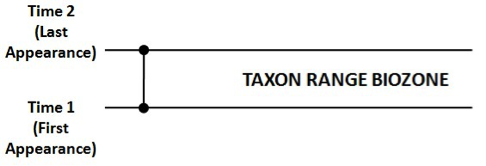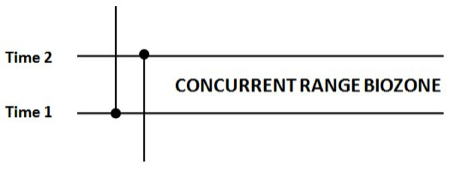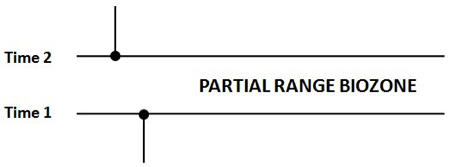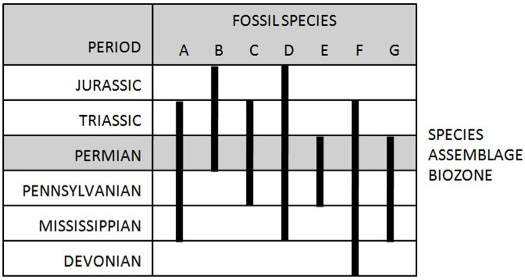Time-Stratigraphic Correlation & Biostratigraphy
Lab 4 introduced the types of stratigraphic correlation that can be used to match materials from one borehole location to another:
- Lithostratigraphic correlation: Rocks of equivalent type or facies are matched.
- Time-stratigraphic correlation: Rocks of equivalent relative (or absolute) age are matched.
- Biostratigraphic correlation: Rocks containing the same fossil or fossil assemblage are matched, without considering rock type.
You practiced lithostratigraphic correlation in Lab 4 by matching beds and facies between stratigraphic logs, as well as some time-stratigraphic correlation. This lab will focus on time-stratigraphic and biostratigraphic correlation. This requires that you be able to match rocks on one particular range of geological time to others of the same time, even if those other rocks are from a different facies, using fossils or fossil assemblages.
Biostratigraphy is the correlation of stratigraphic units based on fossil content, either through the use of index (guide) fossils or similarities in fossil assemblages. An index fossil is a useful guide for correlation if it possesses the following characteristics:
- It has widespread geographical distribution.
- It exists in the fossil record over a relatively short interval of time (referred to as its geological range).
- It is abundant in the fossil record.
- It is easily identified.
Few fossil species meet all these criteria and it is more common to use multiple fossil species or fossil assemblages to define a biostratigraphic unit. The fundamental biostratigraphic unit is a biozone (in this case the term “zone” is used to refer to a rock facies or a sequence of facies). Several types of biozones can be defined that help place fossils in their time-stratigraphic position, and to date the rocks in which they occur.
1. Taxon Range Biozone
This refers to the total geological range of a particular fossil, from the first time it appears in the fossil record, until the last time it appears (Figure 9.1).

2. Concurrent Range Biozone
This is the interval of relative geologic time defined by the overlap of several taxa which have longer taxon range biozones (Figure 9.2).

3. Partial Range Biozone
This is an interval over which the taxon range biozones of two fossils do not overlap (Figure 9.3). This type of biozone can sometimes be hard to determine as the absence of a fossil could just mean that none were preserved, not that they were absent.

4. Species Assemblage Biozone
This is an expanded version of a concurrent range biozone determined by the presence of multiple fossils, all of which have broad ranges. This grouping, or assemblage, of fossils is biostratigraphically distinguishable from adjacent strata. In the Figure 9.4, the fossil species A to G appear together only during the Permian Period.

5. Peak Biozone
The peak biozone is the relative geological period of maximum species abundance. Abundance refers to the number of individuals of a particular taxon in a certain volume of sediment. Recall from Labs 6-8 that most of the phyla you have learned about have periods of peak abundance. Figure 9.5 shows the range biozone of each taxon as a black bar, and the peak biozone is indicated by a thicker segment along the bar. Notice that not all of the taxa in Figure 9.5 have peak biozones.

